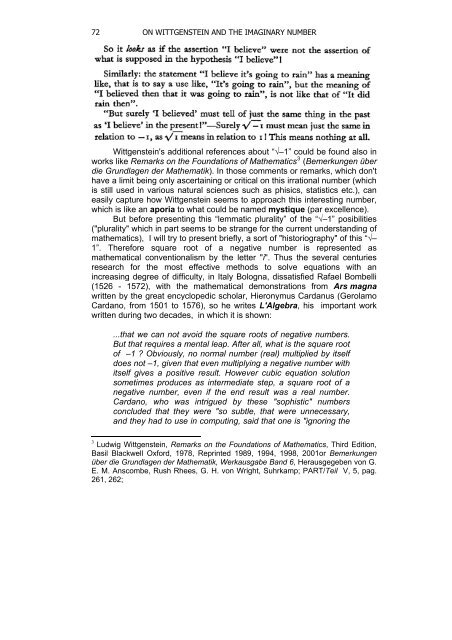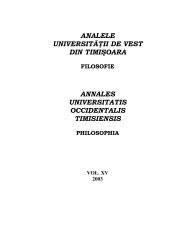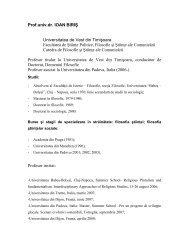VOL. IV (XXI) 2009 - Departamentul de Filosofie si Stiinte ale ...
VOL. IV (XXI) 2009 - Departamentul de Filosofie si Stiinte ale ...
VOL. IV (XXI) 2009 - Departamentul de Filosofie si Stiinte ale ...
You also want an ePaper? Increase the reach of your titles
YUMPU automatically turns print PDFs into web optimized ePapers that Google loves.
72 ON WITTGENSTEIN AND THE IMAGINARY NUMBER<br />
Wittgenstein's additional references about “√–1” could be found also in<br />
works like Remarks on the Foundations of Mathematics 3 (Bemerkungen über<br />
die Grundlagen <strong>de</strong>r Mathematik). In those comments or remarks, which don't<br />
have a limit being only ascertaining or critical on this irrational number (which<br />
is still used in various natural sciences such as phi<strong>si</strong>cs, statistics etc.), can<br />
ea<strong>si</strong>ly capture how Wittgenstein seems to approach this interesting number,<br />
which is like an aporia to what could be named mystique (par excellence).<br />
But before presenting this “lemmatic plurality” of the “√–1” po<strong>si</strong>bilities<br />
("plurality" which in part seems to be strange for the current un<strong>de</strong>rstanding of<br />
mathematics), I will try to present briefly, a sort of "historiography" of this “√–<br />
1”. Therefore square root of a negative number is represented as<br />
mathematical conventionalism by the letter "i". Thus the several centuries<br />
research for the most effective methods to solve equations with an<br />
increa<strong>si</strong>ng <strong>de</strong>gree of difficulty, in Italy Bologna, dissatisfied Rafael Bombelli<br />
(1526 - 1572), with the mathematical <strong>de</strong>monstrations from Ars magna<br />
written by the great encyclopedic scholar, Hieronymus Cardanus (Gerolamo<br />
Cardano, from 1501 to 1576), so he writes L'Algebra, his important work<br />
written during two <strong>de</strong>ca<strong>de</strong>s, in which it is shown:<br />
...that we can not avoid the square roots of negative numbers.<br />
But that requires a mental leap. After all, what is the square root<br />
of –1 ? Obviously, no normal number (real) multiplied by itself<br />
does not –1, given that even multiplying a negative number with<br />
itself gives a po<strong>si</strong>tive result. However cubic equation solution<br />
sometimes produces as intermediate step, a square root of a<br />
negative number, even if the end result was a real number.<br />
Cardano, who was intrigued by these "sophistic" numbers<br />
conclu<strong>de</strong>d that they were "so subtle, that were unnecessary,<br />
and they had to use in computing, said that one is "ignoring the<br />
3 Ludwig Wittgenstein, Remarks on the Foundations of Mathematics, Third Edition,<br />
Ba<strong>si</strong>l Blackwell Oxford, 1978, Reprinted 1989, 1994, 1998, 2001or Bemerkungen<br />
über die Grundlagen <strong>de</strong>r Mathematik, Werkausgabe Band 6, Herausgegeben von G.<br />
E. M. Anscombe, Rush Rhees, G. H. von Wright, Suhrkamp; PART/Teil V, 5, pag.<br />
261, 262;




